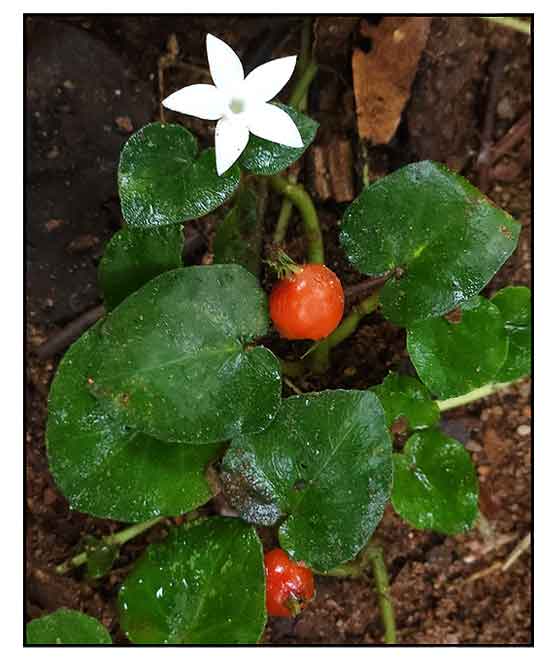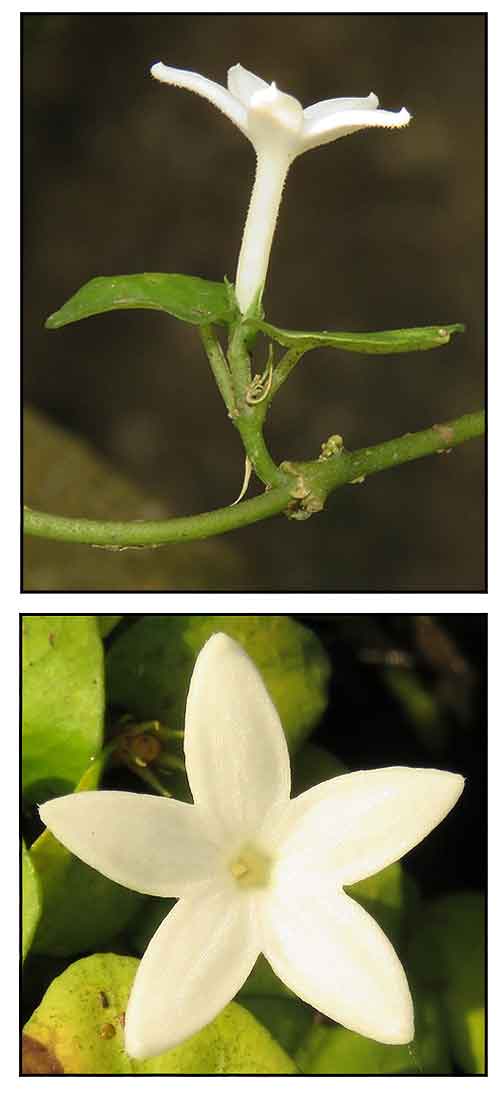
Family • Rubiaceae
Snake pennywort
Geophila herbacea (Jacq.) K.Schum.
GEOPHILA
| Scientific names | Common names |
| Carinta herbacea (Jacq.) W.Wight | Geopila (General) |
| Carinta repens var. comorensis Bremek. | Snake pennywort (Engl.) |
| Carinta uniflora (Hiern) G.Taylor | |
| Cephaelis diversifolia Blume | |
| Cephaelis herbacea (Jacq.) Kurz | |
| Geocardia cordata (Miq.) Standl. | |
| Geocardia herbacea (Jacq.) Standl. | |
| Geophila cordata Miq. | |
| Geophila diversifolia (Blume) DC. | |
| Geophila herbacea (Jacq.) K.Schum. | |
| Geophila hydrocotyloides Zipp. ex Span. | |
| Geophila reniformis D.Don | |
| Geophila reniformis var. asiatica Rheede ex Cham. & Schltdl. | |
| Geophila repens var. asiatica Rheede ex Cham. & Schltdl. | |
| Geophila repens subsp. reniformis (D.Don) M.R.Almeida | |
| Geophila uniflora Hiern | |
| Geophila uniflora Span. | |
| Mapouria cordata (Miq.) Müll.Arg. | |
| Mapouria herbacea (Jacq.) Müll.Arg. | |
| Mapouria herbacea var. minor Müll.Arg. | |
| Psychotria herbacea Jacq. | |
| Psychotria sylvana Pers. | |
| Psychotrophum herbaceum (Jacq.) Crantz | |
| Uragoga herbacea (Jacq.) Kuntze | |
| Uragoga reniformis (D.Don.) M.Gómez | |
| Geophila herbacea is an accepted species. KEW: Plants of the World Online | |
| Note: Common name 'Snake pennywort' is shared by both Geophila herbacea and G. repens. | |
| Other vernacular names |
| AFRICA: Ododo, Ogbo. |
| COOK IS.: To'etupu, To'etupou, Po'epo'e tai, Tono, Togo. |
| INDIA: Mandukaparni, Brahmi, Saraswati, Karumutthil (Tamil), |
| MALAYSIA: Pegaga tekukur, Pegaga ular. |
| SAMOAN: Naunau. |
| SOUTHEAST ASIA: Daun kerdas, Selusuh. |
| SRI LANKA: Koturu-bedde, Agukarni, Koturubedda, Meekanpala, Makunuweena (Sinhala) |
| THAI: Mali din, Uttaphit nam. |
- Assay of ethanolic extract of Geophila herbacea isolated a new compound, 2-phenylethyl 2,6-dihydroxybenzoate. (see study below) (4) Properties Studies Availability |
June 2025
![]()
 |
| PHOTOS / ILLUSTRATIONS |
| IMAGE SOURCE: Rubiaceae: Snake pennywort (Geophila herbacea) / © Deepachandran / Some rights reserved / NC BY-SA / Click on image or link to go to source page / iNaturalist |
| OTHER IMAGE SOURCE: Rubiaceae: Snake pennywort (Geophila herbacea) / Close-up of flower / © Reuben C J Lim / CC BY-NC-SA 2.0 Generic / Click on image or link to go to source page / flickr |
| OTHER IMAGE SOURCE: Rubiaceae: Snake pennywort (Geophila herbacea) / Flowering stem / © Reuben C J Lim / CC BY-NC-SA 2.0 Generic / Click on image or link to go to source page / flickr |
Additional
Sources and Suggested Readings |
• |
DOI: It is not uncommon for links on studies/sources to change. Copying and pasting the information on the search window or using the DOI (if available) will often redirect to the new link page. (Citing and Using a (DOI) Digital Object Identifier) |
| List of Understudied Philippine Medicinal Plants |
| New plant names needed The compilation now numbers over 1,500 medicinal plants. While I believe there are hundreds more that can be added to the collection, they are becoming more difficult to find. If you have a plant to suggest for inclusion, native or introduced, please email the info: scientific name (most helpful), local plant name (if known), any known folkloric medicinal use, and, if possible, a photo. Your help will be greatly appreciated. |
• |
 |

 Gen info
Gen info
